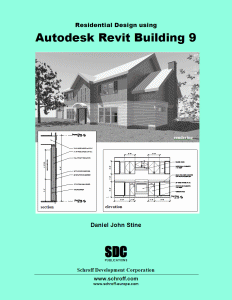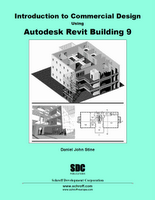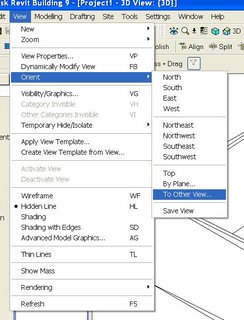Thursday, October 19, 2006
CDV Systems Video Review
The videos are well organized into 68 vignettes based on topic. The content is accurate and concise. There are also some tips and tricks which the help files don't tell you, these are gems. The only faults that I found was that the audio volume was a little low and the video size had to be adjusted for each of the videos. The price is $30 for each download which I would say is quite reasonable.
Thursday, October 12, 2006
Ontario Revit User's Group
Plan to attend the inaugural Ontario Revit Users Group Meeting with guest speakers from KPMB Architects and Phil Read from Autodesk.
When: Wednesday, October 25th 6:30pm to 9:00pm.
Location: Alice Fazooli's,
Agenda
Reception: Join us for hors d'oeuvres and drinks at 6:30.
Introduction: Meet the Ontario Revit User's Group Organizers and dedicated volunteers who are leading the Revit wave in
Revit - Cross Country Checkup: This year has shown tremendous gains in the adoption
of Revit. Caesar Ruest from Autodesk
ORUG Member Presentation: The Revit team from KPMB Architects will discuss their experience with using Revit on the Manitoba Hydro tower project.
Guest Speaker - Phil Read Speaks on Design Iteration in Revit: Phil is a Revit implementation architect with Autodesk and works directly with firms in training, project implementation, and establishing best practices. Phil holds Bachelor of Science degrees
in Communications and Architecture, as well a Master of Architecture degree from the
Q & A: Use this great opportunity to ask questions about your use of Revit.
Thursday, October 05, 2006
Change a Revit Mass Name
1. Go to the Families listing in the Project Browser
2. Find Mass
3. Find Instance, right-click, rename!
Detailing in Revit
1. Revit doesn't 'do' details, a person does. It seems obvious enough but just because you have the ability to cut sections through components doesn't mean that section will know the specific conditions that you need to communicate...
2. Revit does have a robust set of detailing tools that enable you to draw BETTER details than AutoCAD.
You need to ask the following question before you start detailing:
1. Should I model this in 3D, 2D or both?
These questions help you answer this:
a. Will this condition be visible from any other views?
b. Is this a generic detail that is used over different projects, or is it specific to this one only?
c. How far are we into the design, will this part of the building change drastically?
An good example is a door section.
Will you see the structural lintel and flashing from other views? No, draw it in 2D on top of the section/callout view.
What about the connection to the wall, insulation, frame extrusion shapes etc? Again, no. Draw it in 2D overtop of the section/callout view.
Will I see the masonry lintel from another view? Yes. Model the lintel in the door family in 3D so it shows correctly in sections and elevations.
If the door manufacturer has sent their own pre-engineered detail in AutoCAD just import that file into a Drafting View and link it to a callout. Why 'reinvent the wheel'?!
Friday, September 15, 2006
Ontario Revit Users Group
Plan to attend the inaugural Ontario Revit Users Group Meeting on Wednesday October 25th from 7:00PM to 9:00PM.
Location: Alice Fazooli's, 294 Adelaide Street West, Toronto, ON
Agenda: Introduction to the ORUG organizers, report on Revit usage across Canada, update on Revit development, guest speaker, Q+A, networking, food and drink.
Registration: Please email your interest in attending to Jay Polding at jpolding@cadmicro.com
Friday, September 08, 2006
What's Really New in Revit 9.1
First off, I would like to say, after reviewing this release, GREAT JOB and THANK YOU to the development team. They have listened to us, the users, and fixed some of the persistent issues that have been coming up.
I would categorize the enhancements into two areas:
Talking to other programs
Autodesk has purchased FM Desktop which will allow Revit and AutoCAD to mesh into the Facilities management arena. Great idea. They have also acquired Robobat, a leading engineering calculations software. Great idea. What this means is a more disciplines working based on the Revit model. So this is where the development team has to integrate existing functions into all of the other necessary programs.
Adding common wishlist items
As we all know, details are critical. We make suggestions and the Revit team is listening. Is their reaction time fast enough? We have to balance our reaction to this. No, we don't want them to be complacent but at the same time we need to be realistic. They did fix some of my wishlist items but the major test will be what release 10 fixes and adds.
Here we go...
Selecting units for DWG export (Talking to other programs)(Adding common wishlist items)
You can set the DWG units for projects you export to DWG format. Unit options are feet, inches, meters, centimeters, and millimeters. The default units are inches for imperial projects and meters for metric projects.
Exporting room and area properties to 2D DWF (Talking to other programs)
When you export a project or a view that has rooms or areas to 2D DWF, you can have the room/area properties exported on a separate layer than the geometric representation. Setting this option allows you to view individual rooms and room data when you are exporting a project or a view for use with facility management software (such as Autodesk® FMDesktop), or DWF markup software (such as Autodesk® Design Review).
Specifying the building type and zip code for exported gbXML files (Talking to other programs)(Adding common wishlist items)
You can now specify the building type and zip code for projects that export to gbXML. Several analysis software packages use this information when importing gbXML files to add default design values for energy use and costs, thermal loads, and construction.
Hiding elevation tags(Adding common wishlist items)
You can set the view scale at which elevation tags are hidden in project views. Each elevation tag instance can have a different view scale at which it is hidden.
Improved snapping for section views(Adding common wishlist items)
You can now snap a section line either parallel or perpendicular to a non-orthogonal datum or wall. Snapping to a wall is available in plan views.
Set room bounding condition for columns prior to placement(Adding common wishlist items)(Talking to other programs, especially Revit Structure)
You can now specify whether an architectural column is room bounding before placing it. This setting persists until you change it.
Placing windows and doors on in-place walls in plan view(Adding common wishlist items)
In plan view, you can now place windows and doors on in-place and face-based walls, for example a sloped wall.
Moving end-joined components(Adding common wishlist items)
Components that share a common end join can be moved simultaneously without breaking the join by using a new drag control, or by selecting an option on the context menu. This functionality is available for walls, lines, beams, braces, and line-based families.
New area property for filled region(Adding common wishlist items)
To quickly determine area you can now use the filled region tool and view the new area property.You view the area property for a filled region in its Element Properties dialog. The area value is the area of the region's closed perimeter loop less the area of any closed loops within the perimeter. The area property is reported in the project units (for example, square meters or square feet). The area property is read-only and cannot be scheduled or tagged.
The following topics could be grouped under (Talking to other programs, especially Revit Structure) (Adding common wishlist items)Using the Trim/Extend tool with beams and braces
You can now use the Trim/Extend tool (trim/extend to corner and trim/extend single element options) to trim or extend braces and beams.
Moving braces out of their originating plane
You can now copy, move, mirror, array, and rotate braces out of the vertical plane they were created in. You can accomplish this in plan and 3D views.
Non-planar beam systems
You can create non-planar beam systems in which the elevation of a beam is defined by its sketch lines. Sketched beam lines:
New option for the Layout Rule instance parameterConcrete drawing improvements
Concrete beams that are in the same plane and are joined to the same concrete column (where the beams are wider than the column) automatically clean up.
Automatic concrete joins
Beam Direction Edge tool renamed
New options for sketching beam directions
Different display options for hidden, non-rectangular concrete beams
Independent visibility control for revision clouds and revision tags
Monday, August 28, 2006
Revit 9.1 and Structure 4, SURPRISE!
Wow, that was quick. Here's what Autodesk is saying about this release coming out tomorrow (in Canada anyway):
The Revit Building 9.1 products deliver the best possible information for decision making by increasing support for interoperability and enhancing coordination and quality, while optimizing workflow across the Autodesk Revit product suite. (this is an interchangeable blurb Autodesk uses when it a. doesn't have anything to report b. doesn't want us to know.)
Revit Structure 4 contains many new modeling features, pre-cast concrete and steel content, analytical tools and enhancements for reinforced concrete documentation. Of particular note are the TrussWizard (available only to Subscription customers) and the one-click beam system creation feature. (sound interesting)
Thursday, August 24, 2006
Tell Autodesk how to improve Revit
http://www.revitcc.com
Tuesday, August 22, 2006
Revit Structure - Book Review
Autodesk Official Training Courseware
My Impression:
This is a very good introduction to Revit Structure. The book comes with a CD that contains example projects and tutorials along with a second CD with a full working copy of Revit Structure 3. The course can been done on-screen or by reading the book. All of the examples work and are somewhat realistic. The explanatory text is well written and gives some basic background into structural design.
Residential Revit - Book Review

Residential Design using Autodesk Revit Building 9
Author: Daniel John Stine
SDC Publcations
My Impression:
Some instructional books try to please everybody and become too generic. That's definitely not the case with this one. The basics of Revit are applied to imperial unit based, wood frame residential techniques of most of the USA and Canada. The narrative is conversational and easy to understand but needs a good editor and spell checker. I like the large print and diagrams. The approach is to take one project from preliminary drawings to working drawings, details and renderings etc. All of the essentials are covered but nothing really in-depth. This book will help the residential designer or student get up to speed fast with Revit but needs to be followed up with an advanced version.
Friday, July 28, 2006
Revit Books-Reviews

Mastering Autodesk Building
Author: Paul F. Aubin
Thomspson Delmar Learning/Autodesk Press
My Impression:
Overall, this is a very comprehensive book although I would have to say that the name is misleading. It gives the impression that if you read this book you will master Revit. Not so, there's nothing on rendering or creating camera views and very little is said about materials. In-depth tutorials and explanations are given for most of the main topics and example files are provided on a companion CD. It's over 700 pages so get ready for a lot of reading.

Introduction to Commercial Design Using Autodesk Revit Building 9
Author: Daniel John Stine
SDC Publcations
My Impression:
As an introduction, this is a good start. The reader is taken through a very basic project to demonstrate the funamental tools and what Revit is capable of. There are lots of architectural drafting explanations as to why Revit behaves the way it does. You will finish this book learning the basics and wanting to learn more.
Friday, July 14, 2006
Section Bubbles disappear
This is a setting in the properties of the section mark. This is intended to prevent HUGE section marks at scales like 1:1000 or 1/64"=1'-0". Here's how to change that parameter:
1. Click on section mark
2. Open Properties
3. change the 'Hide at scales coarser than' parameter
This applies to one section annotation at a time.
Tuesday, July 11, 2006
View Levels or Sections in 3D

Let's pretend that you have a 20 storey building and you only want to show level 3 in a 3D isometric view. Or you want to make an axonometric projection of each floor. Or you want to see a 3D version of a 2D section. How do you do this? You could use the Section Box feature alone but sometimes it can be slow, depending on the model. And this is not always precise. Here's an alternative:
1. Go to a 3D view
2. Turn on Section Box (this is automatic, see comments)
3. Pulldown menu View-Orient-To Other View
4. Choose one of your Levels or Sections
Your 3D view will look like it turned 2D, but it didn't. If you use the View-Orient-Northeast tool you will see the results. You could also use the Spin tool.
If you want this to be an axonometric than you will need to do this for each floor and then drag and drop them onto a sheet.
Monday, July 10, 2006
Revit Content Wishlist!
You can comment on this thread or just email me your list :jpoldingATcadmicroDOTcom
Monday, June 12, 2006
Green Autodesk?
They've also sponsored an in-depth PBS documentary about the subject featuring Brad Pitt as narrator. This is also available to be downloaded as audio or video/audio.
www.design-e2.com/
Tuesday, June 06, 2006
Architecture Competition-Importing Sketchup
- Everest Base Camp
- UNDP World Waters Embassy
- Thames Opera House
Here's the competition site:
www.lineofsite.info
Let's show them how Revit can really kick it up a notch!
Friday, June 02, 2006
Revit Builds
Tuesday, May 30, 2006
New Revit Blogs
Green Revit-Brad Hartnagle
http://greenrevit.blogspot.com/
Another jem by Steve Stafford, this blog lists firms that use Revit.
http://www.revitinside.com/
Wednesday, May 24, 2006
Rendering Survey
Friday, May 19, 2006
Walls that keep on going...
1. Drag the wall end back from any other walls.
(please see comments for a better step 1. Thank you commentators!)
2. Click on 'Edit Wall Joins' tool.
3. Click on the end that you don't want to join.
4. Click on 'Disallow Joins' in the options bar.
5. Move the wall back into position (it won't recognize the other walls)
The 'Edit Cut Profile' tool is useful when used in combination with this technique. (We'll talk about that tool another time.)


